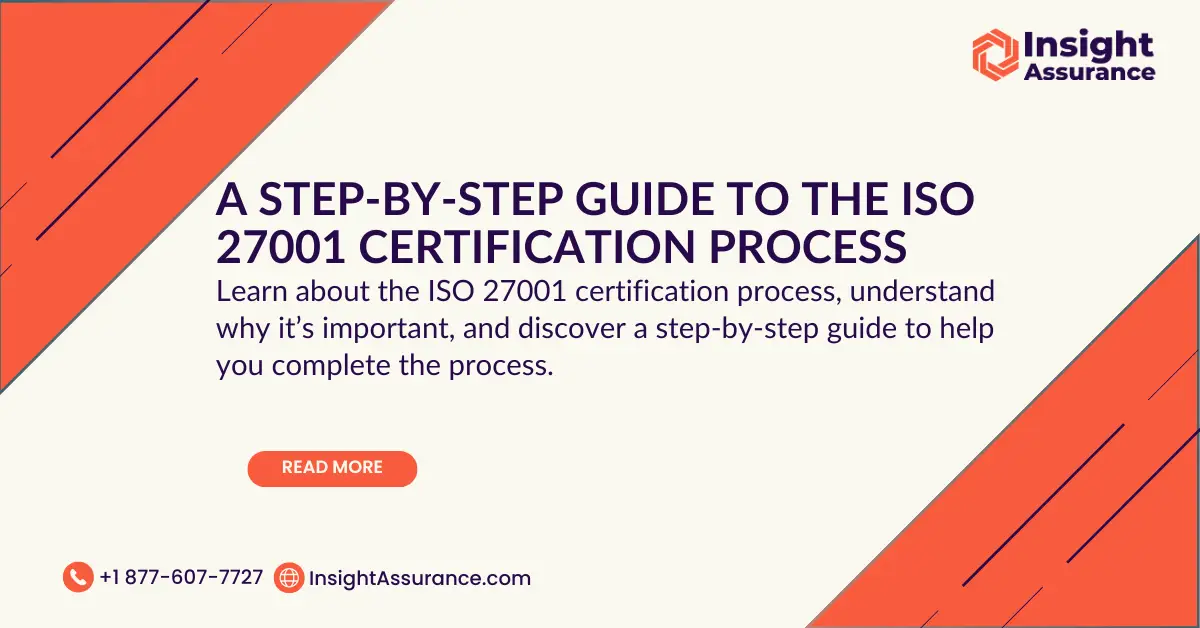Escalating cyber threats and stricter privacy regulations have elevated information security from a technical concern to a board-level priority. Every lost record, service interruption, or headline-grabbing breach chips away at customer confidence and can expose an organization to significant financial penalties.
Against this backdrop, ISO 27001 certification offers a clear, globally recognized path to demonstrate that robust information security management is in place. By aligning with this international standard, organizations can safeguard sensitive data, reassure stakeholders, and streamline compliance with requirements, such as the General Data Protection Regulation (GDPR).
This guide distills the entire ISO 27001 certification process into an actionable, structured roadmap designed for small and medium-sized enterprises (SMEs). Readers will learn how to secure executive buy-in, perform an internal audit, navigate the two-stage certification audit, and maintain continuous compliance — ensuring their businesses remain secure, efficient, and competitive.
Understanding ISO 27001 and Its Importance
ISO 27001 is the foremost international standard for establishing, implementing, maintaining, and continually improving an Information Security Management System (ISMS). Developed by the International Organization for Standardization, ISO 27001 has clear requirements — ranging from leadership commitments to rigorous risk management. Adhering to these helps organizations protect information assets in a systematic, repeatable way.
Because the same requirements apply whether an organization operates in Bangkok, Berlin, or Boston, ISO 27001 provides a common language for demonstrating robust information security to customers, regulators, and partners worldwide.
Earning ISO 27001 certification from an accredited third-party assessor brings tangible advantages that resonate strongly with fast-growing SMEs looking to build credibility while keeping resources lean. Implementing the standard can:
- Strengthen data security by aligning controls with proven industry best practices, dramatically lowering the likelihood of breaches.
- Earn customer trust and accelerate sales cycles by offering third-party validation that information security is of the utmost importance.
- Aid regulatory compliance — such as GDPR, HIPAA, or regional data-protection laws — by providing a structured framework that maps neatly on to many legal obligations.
- Improve operational efficiency through documented processes, clear ownership of risks, and an embedded culture of continuous improvement.
Perhaps most critically, ISO 27001 plays a decisive role in mitigating risks linked to sensitive data. The standard requires a comprehensive risk assessment that identifies threats to confidential information, whether it sits on a cloud server or a developer’s laptop. It also drives a risk-treatment plan tailored to the organization’s context.
By mandating both preventive controls, such as strong access management, and detective measures, such as continuous monitoring, the security standard reduces the potential fallout of ransomware, insider threats, or accidental data loss. For SMEs with limited margins for error, that proactive posture can mean the difference between a minor incident and a costly operational shutdown.
With the importance of ISO 27001 clear, the next question is: How does an organization actually earn the certificate? The following section walks through the initial preparation phase, turning theory into a practical first step toward robust, verifiable security.
Step 1: Preparing for ISO 27001 Certification
Securing leadership commitment is the cornerstone of any successful ISO 27001 certification process. Executives allocate the budget, approve policies, and model the security-first mindset that the ISO standard demands.
Begin with a concise business case that links certification to strategic goals. This could be protecting valuable information assets, accelerating enterprise deals, and reducing compliance overhead. Once management approval is in place, formally define the scope of the ISMS. For SMEs, a focused scope, such as a specific product line or data environment, can streamline implementation efforts and align resources more efficiently, particularly valuable for SMEs managing costs.
Next is a thorough risk assessment and gap analysis. Map out every information asset, evaluate threats — ransomware, insider misuse, etc. — and weigh the likelihood and impact of each scenario. Compare current controls against ISO 27001 requirements to uncover gaps. These could be missing encryption on backups or inconsistent access reviews. Documenting these findings gives the organization a clear, prioritized roadmap for remediation and aligns resources with the highest risks.
Turning insight into action requires a structured project plan. Assign an information security manager or steering committee to oversee milestones, delegate tasks across IT, HR, and operations, and establish regular status reviews. It’s important to keep everybody accountable and to highlight dependencies, such as when policy drafting must precede staff training.
Completing preparation activities sets the stage for successful implementation, but effort alone isn’t enough—auditors will ask for proof. The next step focuses on building strong documentation and capturing evidence that controls are well-designed and operating effectively.
Step 2: Implementing Policies and Controls
With risks prioritized and responsibilities assigned, the next milestone is translating analysis into concrete action. SMEs should craft security policies that align directly with ISO 27001 requirements, ensuring each policy addresses a specific risk from the earlier assessment. It’s critical to document, approve, and communicate policies covering areas such as access control, encryption, incident response, and vendor management. Practical controls might include multi-factor authentication for administrative accounts, encryption of sensitive data at rest and in transit, and documented procedures for managing security incidents. Where resources are limited, leveraging cloud-native security features or reputable open-source tools can reduce implementation costs without sacrificing protection.
Robust policies alone cannot safeguard information assets; employees must understand and embrace them. Comprehensive training programs can turn policies into everyday practice. Consider a blend of brief e-learning modules, live workshops, and periodic phishing simulations to reinforce secure behavior. To keep engagement high, relate security to real-world scenarios such as how a spoofed invoice email could drain the company’s cash flow overnight. Regular awareness campaigns not only reduce human error but also show auditors that the organization values a culture of continual learning.
Once controls are in place, continuous monitoring becomes essential. Key performance indicators — such as the percentage of critical patches applied within 30 days or the frequency of failed login attempts — provide measurable evidence that the ISMS is functioning. Automated dashboards, coupled with scheduled management reviews, help SMEs detect drift early, preventing minor issues from becoming audit findings. Documenting these metrics will prove invaluable during both internal and certification audits.
Establishing policies, training staff, and tracking performance positions the organization to evaluate its readiness objectively. The following section explains how an internal audit uncovers remaining gaps and fine-tunes controls before an external auditor ever steps through the door.
Step 3: Conducting Internal Audits
An internal audit is the dress rehearsal that determines whether the ISMS is stage-ready for external scrutiny. Its primary purpose is to surface nonconformities before they become costly findings in the certification audit, such as gaps between documented procedures and actual practice. By systematically sampling controls, interviewing process owners, and reviewing evidence, the internal auditor validates that policies function as intended and that information assets remain protected.
Thorough documentation underpins a successful internal audit. Auditors should maintain detailed checklists that map each ISO 27001 requirement to relevant evidence, such as access-review logs, encryption configurations, or signed employee training records. Capturing observations, objective evidence, and any nonconformities in an audit report creates a clear action plan for remediation. For SMEs, leveraging audit management software or even a well-structured spreadsheet can streamline evidence collection and ensure nothing falls through the cracks.
Findings from the internal audit serve as a powerful feedback loop. Nonconformities, such as incomplete risk assessments, outdated policies, or missing logs, should trigger corrective actions with defined owners and deadlines. Improvement opportunities, even when not formal nonconformities, can refine controls and bolster security posture. By resolving issues promptly, your organization can display a culture of continuous improvement and reduce the likelihood of surprises during the external assessment.
With gaps addressed and evidence organized, attention turns to the formal certification audit. The upcoming section details the two-stage process every accredited certification body follows and explains how proactive preparation leads to a smoother path to ISO 27001 certification.
Step 4: The Certification Audit Process
An accredited certification body will perform the external certification audit. It unfolds in two distinct stages. Stage one is a documentation review in which the auditor evaluates policies, the Statement of Applicability, and risk-assessment records to confirm alignment with ISO 27001 requirements. Stage two, which the assessor may conduct on-site or virtually, tests operational effectiveness, verifying that controls such as access management, backup encryption, and incident response operate as described.
SMEs that understand common audit findings can tackle them proactively and avoid costly delays. Typical issues include:
- Incomplete or outdated documentation, especially risk assessments and asset inventories,
- Insufficient evidence your organization is monitoring and measuring controls,
- Gaps in employee security awareness training,
- Lack of formal management review or documented corrective actions for previous nonconformities.
Addressing these items before the auditor arrives — through refreshed documentation, evidence dashboards, and meeting minutes — significantly improves the likelihood of passing on the first attempt.
Choosing the right accredited certification body is crucial. Accreditation ensures the auditor follows international rules set by an accreditation body, giving customers and regulators confidence in the certificate’s validity. When evaluating providers, compare industry experience, audit methodology, and total ISO 27001 certification cost, and request sample timelines to ensure they align with business objectives.
Upon successful completion of Stage two, the organization receives the ISO 27001 certificate. But the journey doesn’t end there. The next phase focuses on maintaining compliance through surveillance audits and continuous improvement, ensuring the ISMS remains resilient in an ever-changing threat landscape.
Step 5: Maintaining ISO 27001 Certification
Certification is not a finish line: It signals the start of continuous compliance. Annual surveillance audits performed by the certification body verify that the ISMS still meets ISO 27001 requirements, while internal audits keep day-to-day operations on track. SMEs benefit from scheduling internal audits six months before each surveillance audit, giving teams enough runway to remediate any issues without disrupting business-as-usual activities.
Sustained compliance hinges on ongoing risk assessments and dynamic policy updates. Every new vendor integration, product release, or regulatory change can introduce fresh threats to sensitive data. By repeating the risk-assessment cycle annually — or whenever major changes occur — organizations can recalibrate controls to address emerging challenges like zero-day vulnerabilities or evolving ransomware tactics. Updating policies, the Statement of Applicability, and training content in lockstep ensures that documentation mirrors current practice and remains audit-ready.
Recertification audits occur every three years and resemble a condensed version of the original two-stage audit. To prepare, SMEs should:
- Conduct a comprehensive internal audit that covers every clause and Annex A control.
- Review surveillance audit reports and confirm that all nonconformities have been closed.
- Refresh risk assessments, asset inventories, and management reviews to ensure they reflect the latest business context.
This proactive approach minimizes surprises, reduces recertification costs, and demonstrates a mature, well-governed ISMS.
By embedding continuous improvement into daily operations, organizations transform ISO 27001 from a one-time project into a strategic advantage. The final section recaps the journey and highlights how certification empowers SMEs to build a resilient, trusted, and competitive business.
Achieving Security and Compliance Excellence
ISO 27001 certification is more than a framed certificate on the wall. It embeds a security-first culture that permeates every process, decision, and relationship. By following a structured certification process, SMEs can show unwavering commitment to protecting confidential information, satisfy demanding clients, and unlock new market opportunities that favor verified security practices. The result is a resilient organization that meets regulatory compliance obligations while gaining a measurable competitive edge.
Frequently Asked Questions
Here are some FAQs about the ISO 27001 certification process:
What Are the Primary Benefits of ISO 27001 Certification?
ISO 27001 certification provides numerous advantages, including enhanced protection of sensitive data, reduced risk of data breaches, improved regulatory compliance, and increased customer trust. Additionally, it displays a commitment to information security, which can help attract larger clients and unlock new market opportunities.
How Much Does ISO 27001 Certification Cost?
The cost of ISO 27001 certification varies depending on factors such as the size and complexity of the organization, the scope of the ISMS, and whether external consultants or automation tools are involved.
What Does the ISO 27001 Audit Process Involve?
The audit process consists of two stages. Stage one involves a review of the organization’s documentation, such as policies and risk assessments, to ensure alignment with ISO 27001 requirements. Stage two evaluates the operational effectiveness of the implemented controls. After certification, annual surveillance audits and a recertification audit every three years are required to maintain compliance.
How Long Does It Take To Achieve ISO 27001 Certification?
The timeline for achieving ISO 27001 certification depends on the organization’s preparedness and resources. For SMEs, the process typically takes 6 to 12 months, encompassing preparation, implementation, internal audits, and the two-stage certification audit.
Is ISO 27001 Certification Mandatory?
ISO 27001 certification is not mandatory, but it is highly beneficial for organizations that handle sensitive data, work with large enterprises, or operate in regulated industries. It serves as a recognized benchmark for information security and provides a competitive advantage in the marketplace.
Ready to turn intent into achievement? Contact Insight Assurance to strengthen your ISMS and prepare confidently for ISO 27001 certification.


